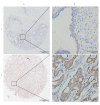Increased Expression of c-Met is Associated with Chemotherapy-Resistant Breast Cancer and Poor Clinical Outcome
- PMID: 30444219
- PMCID: PMC6251073
- DOI: 10.12659/MSM.913514
Increased Expression of c-Met is Associated with Chemotherapy-Resistant Breast Cancer and Poor Clinical Outcome
Abstract
BACKGROUND The relevance of c-Met expression as a prognostic or predictive clinical indicator in chemotherapy-resistant breast cancer remains unknown. The aims of this study were to investigate the expression of c-Met in breast cancer tissues and its association with expression of type II topoisomerase (TOPO II), including in patients who received neoadjuvant chemotherapy (NAC), and to investigate chemotherapy resistance in vitro in breast cancer cell lines. MATERIAL AND METHODS Tissue samples from 255 patients with breast cancer, with matched adjacent normal breast tissue, were used in tissue microarrays (TMAs). c-Met protein expression levels were determined using immunohistochemistry. Forty-five cases of breast cancer treated with NAC were studied to investigate the association between c-Met and TOPO II expression and clinical outcome. Chemotherapy resistance was evaluated in vitro in the MCF-7 and MDA-MB-231 breast cancer cell lines. RESULTS Expression of c-Met protein was increased in breast cancer tissue compared with normal breast tissue. In breast cancer tissue samples, increased c-Met expression was significantly associated with increased Ki-67 expression, tumor size, tumor stage, and TOPO II expression, and with reduced overall survival (OS) rates. Increased c-Met expression and reduced TOPO II expression were associated with chemotherapy resistance. In breast cancer cell lines, knockdown of c-Met expression induced TOPO II expression and increased tumor cell sensitivity to chemotherapy. CONCLUSIONS The findings of this study support a role for c-Met as a clinical prognostic marker and for c-Met and TOPO II as predictive markers for response to chemotherapy in patients with breast cancer.
Conflict of interest statement
None.
Figures




Similar articles
-
The predictive and prognostic significance of pre- and post-treatment topoisomerase IIα in anthracycline-based neoadjuvant chemotherapy for local advanced breast cancer.Eur J Surg Oncol. 2013 Jun;39(6):619-26. doi: 10.1016/j.ejso.2013.02.019. Epub 2013 Mar 7. Eur J Surg Oncol. 2013. PMID: 23473851
-
Serial topoisomerase II expression in primary breast cancer and response to neoadjuvant anthracycline-based chemotherapy.Oncology. 2004;66(5):388-94. doi: 10.1159/000079487. Oncology. 2004. PMID: 15331926
-
The role of topoisomerase IIα in predicting sensitivity to anthracyclines in breast cancer patients: a meta-analysis of published literatures.Breast Cancer Res Treat. 2011 Oct;129(3):839-48. doi: 10.1007/s10549-011-1694-9. Epub 2011 Aug 2. Breast Cancer Res Treat. 2011. PMID: 21809115
-
Topoisomerase II alpha as a marker predicting the efficacy of anthracyclines in breast cancer: are we at the end of the beginning?Clin Breast Cancer. 2003 Aug;4(3):179-86. Clin Breast Cancer. 2003. PMID: 14499010 Review.
-
Current progress in the prediction of chemosensitivity for breast cancer.Breast Cancer. 2004;11(1):42-8. doi: 10.1007/BF02968001. Breast Cancer. 2004. PMID: 14718792 Review.
Cited by
-
Expression of c-MET in Estrogen Receptor Positive and HER2 Negative Resected Breast Cancer Correlated with a Poor Prognosis.J Clin Med. 2022 Nov 26;11(23):6987. doi: 10.3390/jcm11236987. J Clin Med. 2022. PMID: 36498560 Free PMC article.
-
A Quality Control Mechanism of Splice Site Selection Abrogated under Stress and in Cancer.Cancers (Basel). 2022 Mar 30;14(7):1750. doi: 10.3390/cancers14071750. Cancers (Basel). 2022. PMID: 35406522 Free PMC article. Review.
-
Detection of MET Alterations Using Cell Free DNA and Circulating Tumor Cells from Cancer Patients.Cells. 2020 Feb 24;9(2):522. doi: 10.3390/cells9020522. Cells. 2020. PMID: 32102486 Free PMC article.
-
The Significance of MET Expression and Strategies of Targeting MET Treatment in Advanced Gastric Cancer.Front Oncol. 2021 Sep 7;11:719217. doi: 10.3389/fonc.2021.719217. eCollection 2021. Front Oncol. 2021. PMID: 34557411 Free PMC article.
-
Engineered Adoptive T-Cell Therapies for Breast Cancer: Current Progress, Challenges, and Potential.Cancers (Basel). 2023 Dec 26;16(1):124. doi: 10.3390/cancers16010124. Cancers (Basel). 2023. PMID: 38201551 Free PMC article. Review.
References
-
- Holt K. It does matter: Breast cancer is the second leading cause of cancer deaths in American women (American Cancer Society, 2008). Assuming an average lifespan of 85 years, one in eight U.S. women will be diagnosed with breast cancer. Nurs Womens Health. 2010;14(1):34–41. - PubMed
-
- Abdel-Fatah T, Agarwal D, Liu DX, et al. SPAG5 as a prognostic biomarker and chemotherapy sensitivity predictor in breast cancer: A retrospective, integrated genomic, transcriptomic, and protein analysis. Lancet Oncol. 2016;17(7):1004–18. - PubMed
MeSH terms
Substances
LinkOut - more resources
Full Text Sources
Other Literature Sources
Medical
Miscellaneous

